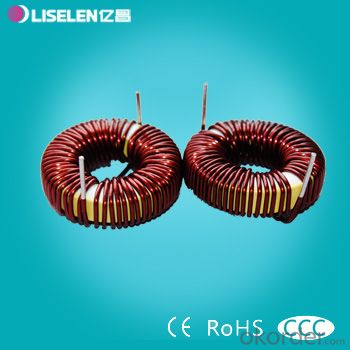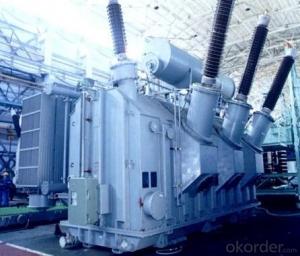Inductance Coil Series Inductance Coil
- Loading Port:
- Tianjin
- Payment Terms:
- TT OR LC
- Min Order Qty:
- 1000 unit
- Supply Capability:
- 50000 unit/month
OKorder Service Pledge
OKorder Financial Service
You Might Also Like

Widely used in home appliances, power supply, modern office equipment, network and communications equipment, power adapter, battery charger and military aerospace and other fields.

Switching power supply transformer has the advantages of high efficiency, small size, light weight, wide application, etc., the output power from a few watts to several thousand watts.




Company have 21 years of business history, set research and development, production and sales as one of professional transformer manufacturing enterprises, also is transformer industry of Shandong Province CQC certification (the original Great Wall certification system, certification time longest enterprises (14 years), mainly produce and sell all kinds of transformer products, including: (transformer Division) three-phase dry type transformer, intelligent three-phase servo transformers, BK\JBK1\JBK3\JBK5 control transformer, toroidal transformer, (small transformer Division) pin, potting type, lead type power transformer series products. (high-frequency transformer Division) EE series, EFD series, PQ series, filter, I-inductor, loop inductance etc..
We are able to supply various types of terminal blocks according to clients' requirement,Please contact us so we can offer you the best quality,competitive price and timely delivery.
- Q: i dont get it. at the end of the movie. they did not kill one of the bad guys and he flew off to out of space?? do u think transformers 2 is gonna come out ???
- God, I hope not. That was a horrendous movie.
- Q: I am working on a lengthy project and have one little area that I am not sure how to answer. I need to know how to size a transformer for a building. Does anybody know the equation or method for doing this? The service coming in is 480Y/277V and the step-down is to a 240/120 single phase panel. Any help is great! Thanks
- buildings come in all sizes. Some use a lot of power, perhaps because of lots of machinery. Others use a much smaller amount. So you need to calculate or estimate the amount of power the building will be using. If you know the square foot total and use of the building (industrial, office, etc) there are probably tables that will give you a guess. One 240/120 panel for the entire building? That implies a very small building, as must buildings distribute 3 phase 208 volts, and have numerous subpanels. .
- Q: Hi,Should i wait for the Asus Transformer Pad Infinity, or should i buy the New iPad ?Thanks,Patrick
- Transformer Pad Infinity. The new iPAD is exactally like the iPAD 2. Dont let them fool you with the X after the A5 on the processor. Technically its the same. The Transformer Pad Infinity is the first Quadcore tablet in the market with the targea 3 and quite frankly thats reason enough to bypass the New iPAD anyday.
- Q: Hi, I'm trying to build a Jacob's ladder or maybe a Tesla coil. What should I use to get enough voltage? A lot of resistors or a transformer? (Are they also safe for humans?)
- I don't think there is any way to use resistors to increase voltage. Neon sign transformers are the usual choice, but they are not safe for humans. Death is not rare and they likely cause illegal radio interference. Voltage multipliers are likely safer, but the Jacob's ladder arc will be dimmer and shorter. Neil
- Q: can i use 12VAC 60w transformer for 12VAC 30w (3 10W) light?
- Yes. 60 watts is the MAXIMUM you can use with that transformer.
- Q: Can the transformer be replaced with a component?
- If you say the transformer is a small power frequency transformer, then you can use switching power supply instead. If the substation with high-power transformers, there is no thing to replace.
- Q: If you have two 12 volt transformers and if we connect their hot wires together does the voltage become 24 or 12 volts?
- There is actually a phasing to the transformer windings. If you connect them in series with the phases adding (both hit + 12 at the same instant) you get 24 volts out. If you connect with the phasing wrong (one hits +12 while the other hits -12) and put them in series the output will be zero volts (and they might overheat). If you connect them in parallel with the right phasing you will get 12 volts and the amperage will add to give you the sum of their amperage. If you connect in parallel with the phasing wrong you will get zero output voltage (and the danger of overheating). If the transformers do not make their phasing clear put a voltmeter on the output and briefly turn on the primary while seeing if you get zero or the voltage you want. If the phasing is wring swap the wires of one transformer around and check with the meter again.
- Q: Hello,Recently, my air conditioner broke and I hired a man to come fix the machine. Unfortunately, he did not help my situation and possibly made it worst.Initially, he informed me that my transformer was broken and so said that it needed replacement. However, when he replaced the transformer, both the transformer and the circuit board blew out. Now, he's making me pay, not only pay for his services, but also for the two additional parts. My question is: Is is possible that the circuit board caused this issue? Or did he mess up on the wiring and blow both parts out, by mistake?I just need to know, so I don't pay for something, originally not of my cause.Thank-you.
- Transformers don't normally fail for no reason. In most cases, something caused the transformer to fail, so it is incumbent upon the person servicing the unit to figure that out first before installing another transformer and powering it up. If it can't be determined what caused the failure, it is best to install an in-line fuse so, if there is an issue, the fuse will blow before taking out the transformer and the circuit board. Having said that, in a lot of cases, the circuit board has its own built-in fuse to protect the board from cases such as yours, so the board fuse should have blown before the board became damaged. I don't have much confidence in what your man did, so I'm more likely to blame him for blowing out your circuit board and the new transformer, unless he can prove otherwise.
- Q: come on.the battle scenes and all the transformers were totally awesomebut.all the small jokes that sam and his parents and other various characters madejust killed itlike they were actually trying to add a comic element to it.and what is with the transformers cussing? it doesnt feel righttransformers dont cuss.lol
- never even saw it so . . .
- Q: How is the insulation of the transformer divided?
- Transformer insulation can be divided into internal insulation and external insulation, the insulation is part of the tank insulation, external insulation is the upper part of the casing and the insulation between each other.
Send your message to us
Inductance Coil Series Inductance Coil
- Loading Port:
- Tianjin
- Payment Terms:
- TT OR LC
- Min Order Qty:
- 1000 unit
- Supply Capability:
- 50000 unit/month
OKorder Service Pledge
OKorder Financial Service
Similar products
Hot products
Hot Searches
























